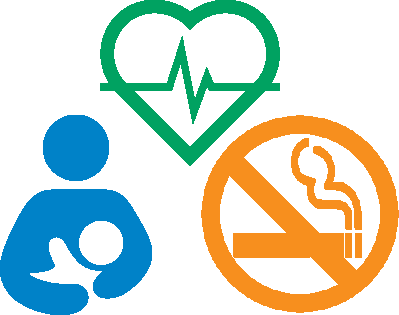About Health Indicator Reports
Health indicators are summary measures that are designed to describe particular aspects
of a population's health or health system performance.
The U.S. Government Accountability Office (GAO) found that comprehensive key indicator systems
had the following positive effects:
- Enhanced collaboration to address public issues.
- Provided tools to encourage progress.
- Informed decision making and improved research.
- Increased public knowledge about key issues.
NJSHAD Indicator Reports are brief online reports that contain data, graphs, and contextual
information for a specific public health issue, such as why it's important,
what the current status is, and what is being done to improve it. Each Indicator
Report has a graph (or several graphs) to give a picture of the data. Text is
also provided to answer the most commonly asked questions about the specific
topic addressed. More info...
After looking at the Indicator Report for a specific measure, if more detailed data are needed, the Custom Query System is available, or the program office may be contacted directly using the information available in the footer at the bottom of the Indicator Report page.
After looking at the Indicator Report for a specific measure, if more detailed data are needed, the Custom Query System is available, or the program office may be contacted directly using the information available in the footer at the bottom of the Indicator Report page.
Instructions for bringing NJSHAD data tables into Excel or Word are given here.
NJSHAD indicator report pages are automatically formatted to save in PDF format.
The information on the page is saved without the top navigation or left navigation buttons.
Use your browser's Print menu and choose "Save as PDF" or choose "Adobe PDF" as the printer name.
Older browser versions may not have this capability, so update your browser if necessary.
There are three ways to find Indicator Reports in NJSHAD.
 |
Alphabetical/Chronological Index - All indicator reports listed in alphabetical order with the ability to sort by publication date |
 |
Cross-Cutting Index - Indicators categorized by health initiative, data source, or DOH program. |
 |
Health Topics - Indicator reports are listed in corresponding Health Topic pages |
Chart Progress
- Track and evaluate progress toward goals
- Compare trends across time to demonstrate improvement or decline in health status
- Get information to use for program development
- Enhance our ability to do public health assessment
Decision-Making and Focus
- Provide information that will be useful for decision-making
- Guide policy decisions, priorities, and strategic plans
- Compare measures across population subgroups to identify target groups for interventions
- Allocate resources effectively
Understand Data and Provide Education
- Educate the public on what public health is
- Provide public health context to better understand the meaning of public health data
- Ensure adequate understanding of public health data commonly used in decision-making
- Provide focus to data analysis and support functions
- Streamline data collection and reporting capacity
- Focus measurement and reporting on measures that are high-priority
- Standardize and promote familiarity with definitions of priority measures
- Maintain data and information in a central location for easy access for use in producing reports, grant applications, and presentations
- Provide an integrated view of public health services to our customers
Use and reproduction of the information published on this website is encouraged
and may be done without permission. Please refer to the
NJSHAD Citation page for suggested citation styles.
- Each report is on a specific health topic.
- These reports show the status of a public health issue through the use of trend and bar graphs, data tables, and explanatory text.
- All NJSHAD Indicator Reports follow the same format and consist of
- a Default View covering the main point of the health topic and
- a link to a Full Report View (on the left navigation menu) that provides much more information such as
- how New Jersey compares to the U.S.,
- health disparity issues,
- and services available to the public.
- The Default View consists primarily of a graph and a data table. Data Notes, Source(s), Other Views (if any), Definitions, Targets, Current Outlook, and Resources are listed below the data table.
Below are descriptions of each of the pages available from the left navigation buttons.
Other available sections include:
Important Facts
The Important Facts page shows, at a minimum, the following sections:- Definition
- Numerator
- Denominator
- Why Is This Important?
Other available sections include:
- Data Interpretation Issues
- Healthy People Objectives
- Healthy New Jersey Objectives
- How Are We Doing?
- How Does New Jersey Compare With the U.S.?
- What Is Being Done?
- Other Program Information
Data Views
The Data Views button has a drop-down list of all the views available for this indicator. The views are also listed on the main page under "Other Views."Related Indicators
The Related Indicators button has a drop-down list of up to four Related Indicator pages:- Relevant Population Characteristics
- Health Care System Factors
- Risk Factors
- Health Status Outcomes

